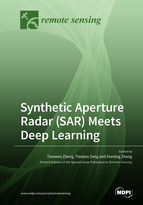Synthetic Aperture Radar (SAR) Meets Deep Learning
A special issue of Remote Sensing (ISSN 2072-4292). This special issue belongs to the section "Remote Sensing Image Processing".
Deadline for manuscript submissions: closed (15 July 2022) | Viewed by 52423
Special Issue Editors
Interests: computer vision; neural networks; object detection/classification/segmentation; remote sensing processing; synthetic aperture radar; millimeter wave radar technology
Special Issues, Collections and Topics in MDPI journals
Interests: computational imaging; inverse imaging problems; image reconstruction; deep learning; neuroimaging; computer vision in remote sensing
Interests: interferometry synthetic aperture radar (InSAR); InSAR remote sensing; remote sensing processing; machine learning and deep learning; detection and classification using SAR images
Special Issues, Collections and Topics in MDPI journals
Special Issue Information
Dear Colleagues,
Synthetic aperture radar (SAR) is an important active microwave imaging sensor whose all-day and all-weather working capacity give it an important place in the remote sensing community. Since the United States launched the first SAR satellite, SAR has received much attention in the remote sensing community, e.g., geological exploration, topographic mapping, disaster forecast, and traffic monitoring. It is valuable and meaningful, therefore, to study SAR-based remote sensing applications.
In recent years, deep learning represented by famous convolution neural networks has promoted huge progress in the computer vision community, e.g., face recognition, driverless field, Internet of things (IoT). Deep learning can enable computational models with multiple processing layers to learn data representations with multiple-level abstractions. This can greatly improve performance of various applications. Today, scholars are realizing the potential value of deep learning in remote sensing. Many remote sensing application techniques have been involved in deep learning, e.g., target and oil spill detection, traffic surveillance, topographic mapping, AI-based SAR imaging algorithm updating, coastline surveillance, and marine fisheries management.
Interestingly, when SAR meets deep learning, how to use this advanced technology correctly needs to be considered carefully, and how to give full play to the best performance of this “black-box” model also needs careful consideration. Notably, deep learning uncritically abandons traditional hand-crafted features and relies excessively on abstract ones of deep networks. Is this reasonable? Can the abstract features of deep networks fully represent real SAR? Should the traditional hand-crafted features provided with mature theories and elaborate techniques be abandoned completely? These questions are worth pondering when one applies various deep learning techniques to the SAR remote sensing community. In general, deep learning is always proposed for natural optical image whose imaging mechanisms are greatly different from SAR.
When SAR meets deep learning, should SAR accommodate itself to deep learning, or should deep learning accommodate itself to SAR? The relationship between the two needs further exploration and research. Furthermore, is deep learning really suitable for SAR? The number of SAR samples is far smaller than that of natural optical images. In this case, could we ensure deep networks learn SAR mechanisms deeply?
This Special Issue provides a platform for researchers to handle the above significant challenges and present their innovative and cutting-edge research results when applying deep learning to SAR, in various manuscript types, e.g., article, letter, review, technical report. Potential topics include but are not limited to the following:
- Object detection and classification;
- Ocean remote sensing;
- Terrain classification;
- Data analytics in the SAR remote sensing community;
- Intelligent SAR agriculture monitoring;
- Interferometric SAR technology;
- SAR image intelligent processing;
- AI-based SAR imaging algorithm updating;
- SAR forest applications;
- Earth observation;
- Marine pollution.
We are looking forward to receiving your contribution to this Special Issue entitled “Synthetic Aperture Radar (SAR) Meets Deep Learning”.
Dr. Tianwen ZhangDr. Tianjiao Zeng
Prof. Dr. Xiaoling Zhang
Guest Editors
Manuscript Submission Information
Manuscripts should be submitted online at www.mdpi.com by registering and logging in to this website. Once you are registered, click here to go to the submission form. Manuscripts can be submitted until the deadline. All submissions that pass pre-check are peer-reviewed. Accepted papers will be published continuously in the journal (as soon as accepted) and will be listed together on the special issue website. Research articles, review articles as well as short communications are invited. For planned papers, a title and short abstract (about 100 words) can be sent to the Editorial Office for announcement on this website.
Submitted manuscripts should not have been published previously, nor be under consideration for publication elsewhere (except conference proceedings papers). All manuscripts are thoroughly refereed through a single-blind peer-review process. A guide for authors and other relevant information for submission of manuscripts is available on the Instructions for Authors page. Remote Sensing is an international peer-reviewed open access semimonthly journal published by MDPI.
Please visit the Instructions for Authors page before submitting a manuscript. The Article Processing Charge (APC) for publication in this open access journal is 2700 CHF (Swiss Francs). Submitted papers should be well formatted and use good English. Authors may use MDPI's English editing service prior to publication or during author revisions.
Keywords
- synthetic aperture radar (SAR)
- deep learning
- convolution neural networks
- computer vision
- detection and classification
- marine pollution








